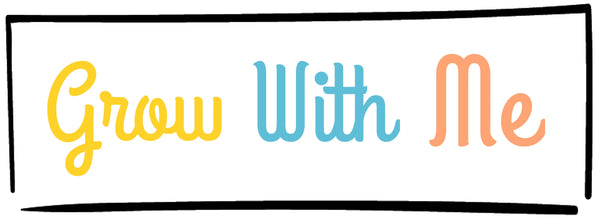
Best Toys for Newborn Development
Share
When you think about toys for a newborn, simplicity is key. The best ones focus on high-contrast visuals, gentle sounds, and interesting textures. Things like black-and-white flashcards or a soft rattle are perfectly tuned to stimulate your baby’s budding senses without overwhelming them.
The Surprising Power of Newborn Play
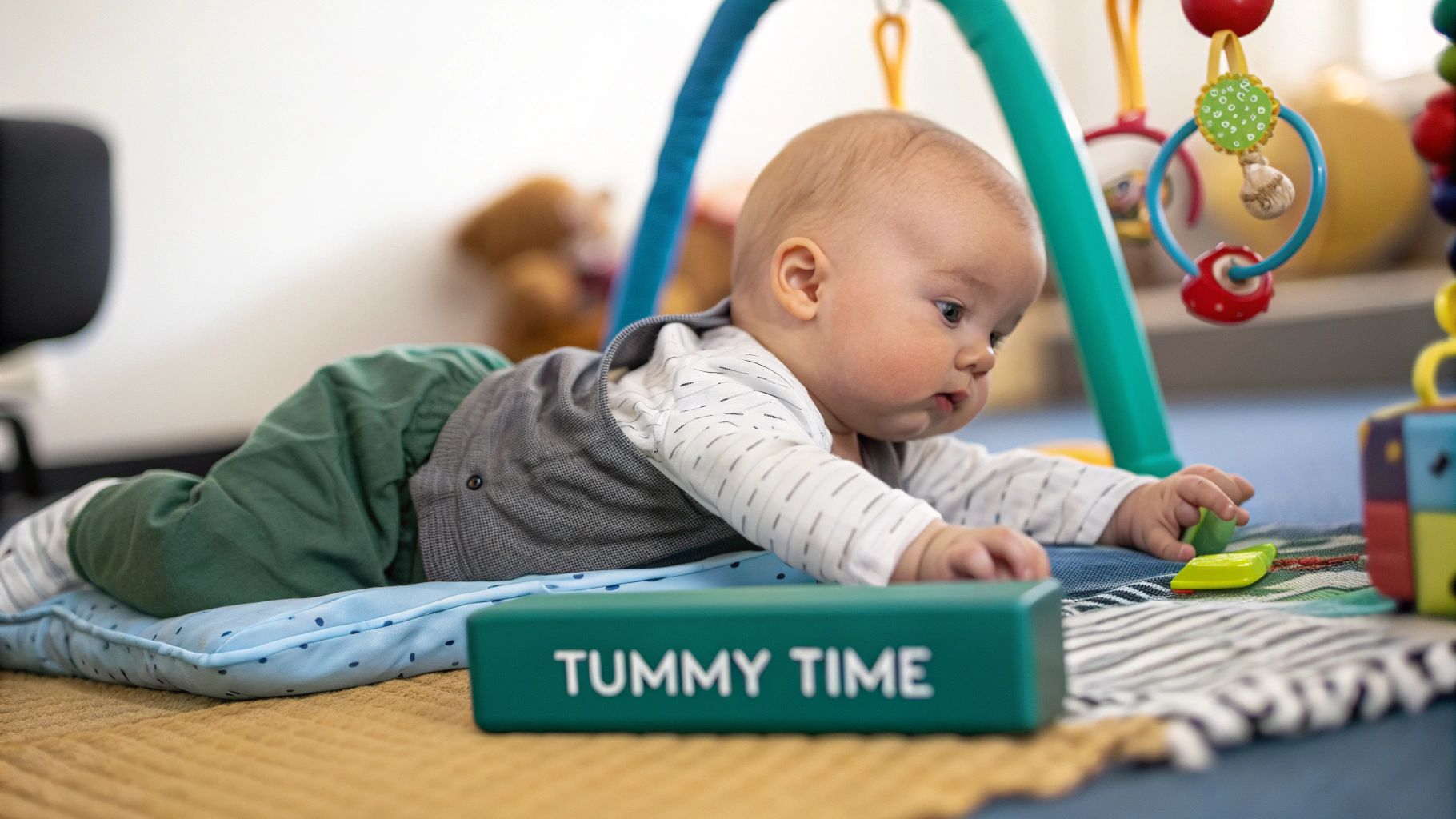
It’s easy to think newborns are too young for proper ‘play’. After all, their days are a cycle of sleeping, eating, and needing a nappy change. But what if we thought of play less as a structured activity and more as a series of simple, sensory moments that build a brilliant little brain?
Believe it or not, your baby's most important work is happening right now, in these quiet, early months. Every seemingly tiny interaction is laying the groundwork for all future learning.
Imagine their brain is like a brand-new city. Each new sight, sound, and touch helps to build another road, eventually creating a vast, intricate network of neural connections.
Building a Brain Through Simple Interactions
This incredible process doesn't need fancy, complicated gadgets. In fact, some of the most powerful developmental tools are the most basic ones. A newborn's brain is beautifully wired to respond to specific sensory inputs that help it start making sense of the enormous new world around it.
It all boils down to a few key experiences:
-
Visual Stimulation: A newborn’s vision is still quite blurry, which is why they’re instinctively drawn to bold, high-contrast patterns. When you slowly move a black-and-white card in front of their face, you’re actually teaching their eyes how to track objects—a fundamental skill needed for reading later on.
-
Auditory Learning: That gentle jingle from a soft rattle is more than just a pleasant distraction. It helps your baby learn to pinpoint where a sound is coming from, encouraging them to turn their head and connect what they hear with what they see.
-
Tactile Exploration: Grasping a soft, textured toy is one of your baby’s first lessons in cause and effect. They begin to understand that their own actions—like squeezing their tiny hand—can make something happen in the world.
The Growing Focus on Developmental Toys
This deeper understanding of early brain development is exactly why there’s been such a big shift towards purposeful play. The market for infant and toddler toys has grown massively, which really shows how parents are changing the way they think about the role of play.
Here in the UK, this is part of a much bigger global trend. The worldwide market for this toy category is now valued at approximately USD 16.7 billion. This huge demand is being driven by parents who want toys that support their baby’s holistic development, right from day one. You can find out more about these trends in this infants and toddlers toy market analysis.
How Play Nurtures Your Newborn’s First Milestones
If you’ve ever found yourself staring at a milestone chart, feeling a little overwhelmed, you’re not alone. What’s my baby supposed to be doing, and when? The good news is, you don’t need a complicated strategy. The simplest, most natural way to support your baby’s growth is through something you’re already doing: playing.
Think of your newborn’s brain like a brand-new computer getting its first software updates. Every little interaction—from watching a high-contrast card to hearing the gentle sound of a rattle—is like installing a crucial bit of code. These little "updates" lay the groundwork for everything that follows.
Here, we'll look at the key milestones for babies from birth to three months. We’ll explore how the right toys for newborn development can support this incredible journey, turning simple playtime into a powerful engine for growth.
The Real Link Between Play and Development
From their very first day, babies are learning. Their brains are firing on all cylinders, forming millions of new connections every second, and play is what fuels this incredible process. It’s not just about keeping them entertained; it’s about building the physical and mental architecture they'll need for life.
Take tummy time, for instance. It might just look like a baby workout, but it’s actually the first step on the road to crawling. When you place an engaging toy just in front of them, you’re giving them a reason to lift their head and push up on their arms. This simple act strengthens the very neck, shoulder, and back muscles they'll need for future mobility.
This chart gives a great overview of how different newborn toys are designed to support various areas of development.
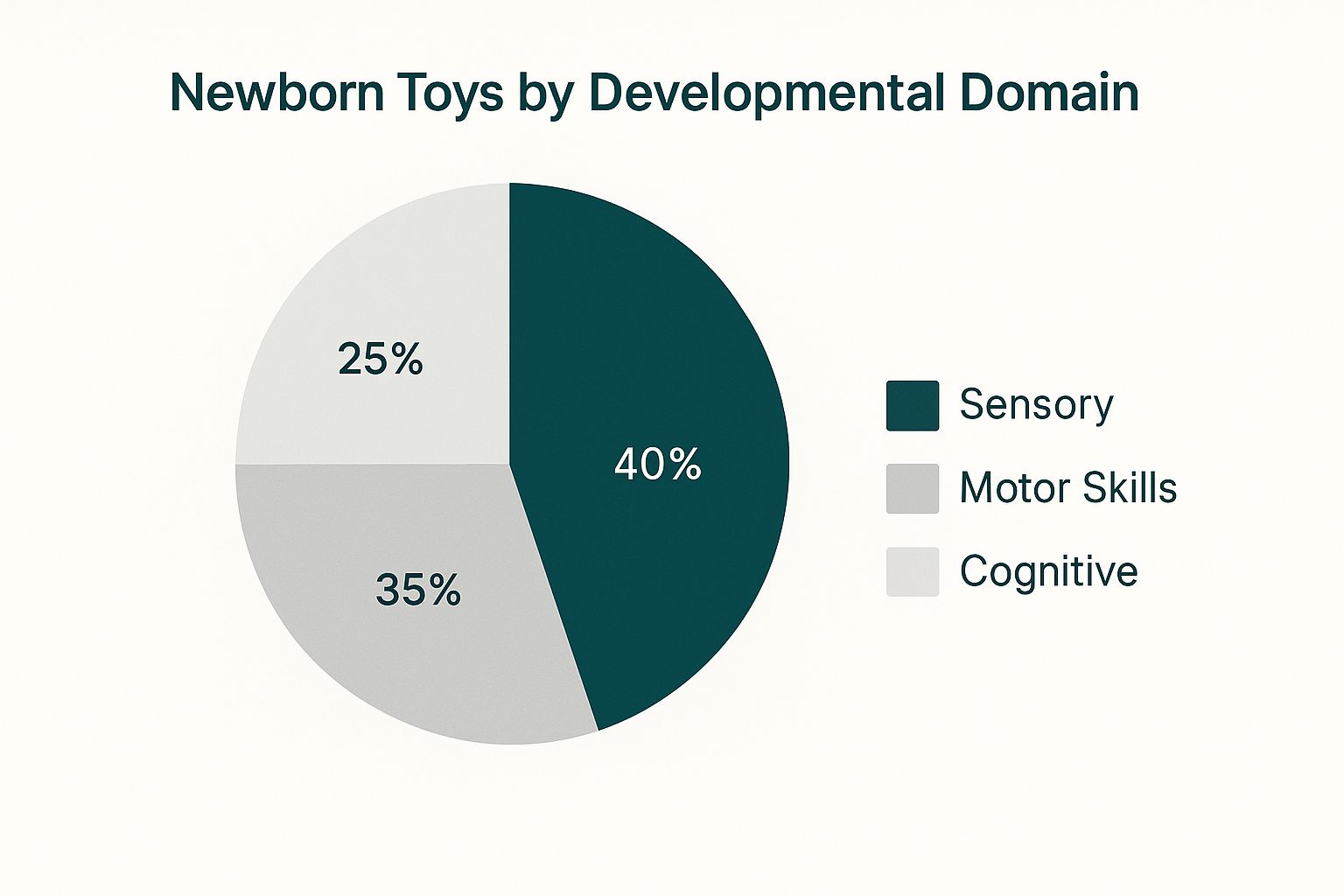
As you can see, there's a strong focus on sensory and motor skills. That’s because these are the main ways newborns begin to make sense of the world around them.
You’ve probably heard that play is the "work of childhood," and for good reason. For a newborn, learning to grasp a rattle or follow an object with their eyes is as fundamental as an adult learning a new skill for their job—it's how they build competence and figure out their environment.
A Quick Guide to Milestones From Birth to Three Months
The first few months are a whirlwind of change. Your baby is rapidly transforming from a tiny being driven by reflexes into an interactive and aware little person. Below is a quick guide connecting these milestones to simple play ideas.
Newborn Milestones and Supporting Play (0-3 Months)
| Developmental Milestone | What It Looks Like | Play Activity or Toy Type |
|---|---|---|
| Developing Vision & Focus | Baby stares intently at objects 20-30 cm away, starts to follow movements with their eyes. | Show them high-contrast flashcards (black and white patterns are best), or use a play gym with bold, simple hanging toys. |
| Head and Neck Control | During tummy time, they begin to lift their head, even for a few seconds. | Place an unbreakable mirror or a captivating toy just in front of them during supervised tummy time. |
| Discovering Hands | Baby starts to notice their own hands, bringing them towards their face and mouth. | Wrist rattles or soft toys that are easy for them to bat at encourage this self-discovery. |
| Hearing and Responding | They startle at loud noises but are calmed by familiar voices or soft sounds. | Gently shake a soft rattle or a bell toy near them, moving it from one side to the other to encourage tracking. |
| Grasping Reflex | Their little hands will instinctively close around your finger or a toy placed in their palm. | Offer a lightweight, easy-to-hold rattle or a soft teething ring for them to practise their grip. |
By seeing these connections, play stops feeling like another task on your to-do list. Instead, it becomes a series of meaningful, joyful moments that directly shape your baby's future.
Why This Matters for Parents Today
Parents are more aware than ever of how crucial play is for early development. This awareness has fuelled significant growth in the UK's toy market for young children, meaning we now have access to more high-quality, research-backed options than ever before. You can dive deeper into the United Kingdom toys market growth on expertmarketresearch.com.
Ultimately, understanding these early milestones helps you choose toys with purpose. You're not just buying something to keep them busy; you're providing the tools they need to explore, learn, and grow.
Choosing the Right Toys for Your Newborn
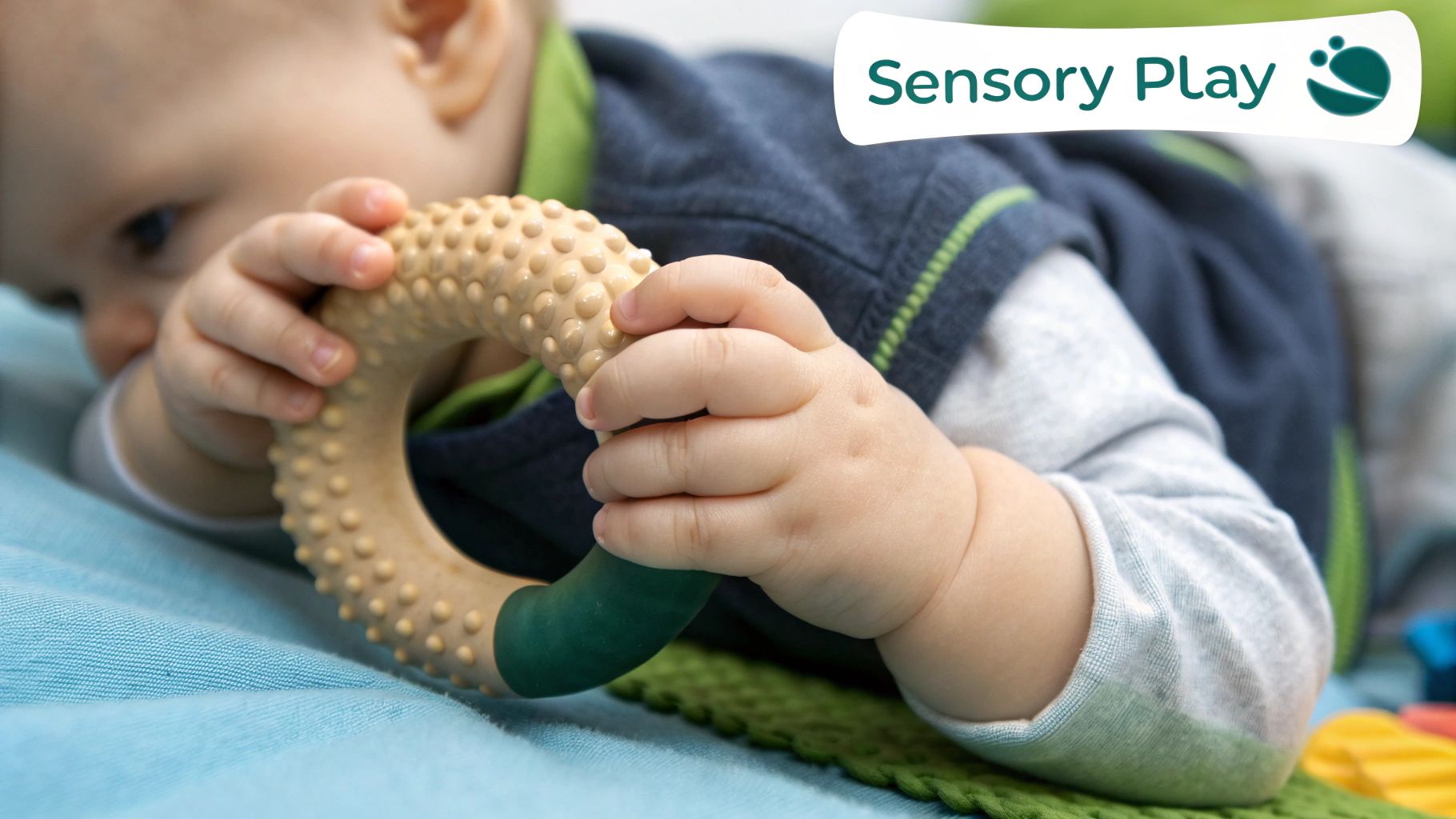
Walking into the baby aisle for the first time can be overwhelming. It feels like a sea of brightly coloured plastic, and everything claims to be the "best" for your little one. So, how do you sort through the noise and find toys for newborn development that genuinely make a difference?
The secret isn't about buying more; it's about choosing smarter. Instead of cramming the nursery full, think about creating a small, purposeful collection of toys. Adopting a "less is more" mindset saves you money and space, but more importantly, it prevents your baby from feeling overstimulated. A handful of well-chosen items will always offer more developmental value than a mountain of gadgets.
This way, you can focus on quality and safety, making sure every toy has a clear role to play in your baby's earliest discoveries.
Core Principles for Selecting Newborn Toys
Before we jump into specific types, it helps to have a mental checklist. A great toy for a newborn is almost always simple, safe, and sensory-rich. It should invite them to explore, not just passively watch.
Think of it like stocking a kitchen. You want pure, high-quality ingredients that you can use in all sorts of ways, not a pre-packaged meal that only does one thing.
Here’s a simple checklist to keep in mind:
- Simplicity: Does the toy do one or two things really well? Often, a simple wooden rattle offers more learning potential than a complex electronic toy with flashing lights and a dozen sounds.
- Safety: Is it made from non-toxic, baby-safe materials? Always look for the UKCA or CE safety marks and double-check for any small parts that could come loose.
- Sensory Engagement: Does it appeal to their brand-new senses? High-contrast patterns for sight, gentle sounds for hearing, and interesting textures for touch are what you're looking for.
Essential Toy Categories for Early Development
With these principles guiding you, it’s much easier to pick out items that are proven to support those early milestones. These are the foundational pieces of your baby’s first toolkit for learning about the world.
1. High-Contrast Visuals
A newborn’s eyesight is still a bit fuzzy, making it tricky for them to see subtle shades and pastels. Bold, black-and-white patterns are a different story—they provide a strong, clear visual signal that their developing brain can easily process.
- What to look for: Soft fabric books with simple shapes, high-contrast flashcards to prop up during tummy time, or a play mat with a bold, graphic design.
2. Gentle Sound-Makers
Toys that make a soft noise when your baby moves them are fantastic for teaching a crucial lesson: cause and effect. It’s their first "I can make things happen!" moment when they realise, "When I shake this, it makes a noise!"
- What to look for: A lightweight rattle that's easy for tiny hands to grasp, soft wrist rattles that jingle with every wave, or a cuddly toy with a gentle bell hidden inside.
3. Varied Textures
Touch is one of the primary ways babies learn about the world around them. Introducing toys with different surfaces—smooth, bumpy, crinkly, soft—gives their brain a steady stream of new information to categorise and understand.
You can dive deeper into this fascinating topic and explore more about the benefits of sensory toys for babies in our detailed guide.
When you're choosing toys, remember that a baby's brain is wired for connection, not consumption. The best "toy" in the world is always you—your face, your voice, and your touch. Everything else is just a tool to enhance that interaction.
By focusing on these core categories and keeping simplicity and safety at the forefront, you'll create a wonderful environment that nurtures your baby's natural curiosity and supports their healthy development right from the start.
Should You Try a Baby Toy Subscription Box?
Toy subscription boxes are everywhere these days. You’ve probably seen them on social media – beautifully curated play kits designed for specific developmental stages, delivered right to your door. They promise to solve a real headache for new parents: knowing which toys for newborn development are actually right for your baby right now. But are these 'grow with me' kits really worth it?
The main draw is, without a doubt, the sheer convenience. Instead of sinking hours into researching developmental milestones and then hunting down the perfect toys, a box just shows up. Inside, you'll find exactly what your baby is ready to explore for their current window of learning. It completely removes the guesswork.
For many parents, this is a massive weight off their shoulders. You get the peace of mind that the items are not just fun but also safe, often made from high-quality, sustainable materials like solid wood or organic cotton. It simplifies things so you can spend less time stressing over shopping and more time actually playing.
Weighing the Pros and Cons
Of course, it’s not a one-size-fits-all solution. Like anything, subscription boxes have their upsides and their downsides. It's worth taking a moment to think about what works for your family before signing up.
Potential Benefits of a Subscription:
- Expert Curation: You're getting toys picked by child development specialists who know precisely what skills your baby is working on.
- High-Quality Materials: Most reputable boxes focus on non-toxic, durable, and often eco-friendly toys that are built to last.
- Saves Time: The mental energy and hours you save on research and shopping are significant.
- Reduces Clutter: Receiving a few, perfectly targeted toys at a time helps avoid that overwhelming mountain of plastic that so often takes over the living room.
On the other hand, you have to consider the potential drawbacks. The most obvious one is cost. A subscription can feel more expensive upfront than buying toys individually, especially if you’re a savvy sale shopper or get lots of gifts. There’s also always a chance your baby just won’t be that interested in a particular toy, leaving you with a beautifully crafted item that does little more than collect dust.
It's so important to remember that no single toy is magic. The real value is in the interaction it sparks between you and your baby. A subscription box is a fantastic tool, but it can never replace engaged, responsive playtime together.
Is a Toy Subscription Right for You?
Ultimately, this is a really personal decision. If you value expert guidance, love the idea of high-quality toys arriving without any effort, and have the budget for it, a subscription can be a brilliant way to support your baby’s learning. It offers a thoughtful, structured approach to play without adding to your already full plate.
If you want to dive a bit deeper, you can learn more about how a baby subscription box in the UK works and see if the model fits your family’s rhythm.
However, if you genuinely enjoy the hunt for the perfect toy or are working with a tighter budget, building your own collection is just as wonderful. The most important thing isn't where the toys come from, but that your newborn has simple, safe, and engaging things to explore their brand-new world with.
Finding Learning Tools Beyond the Toy Box
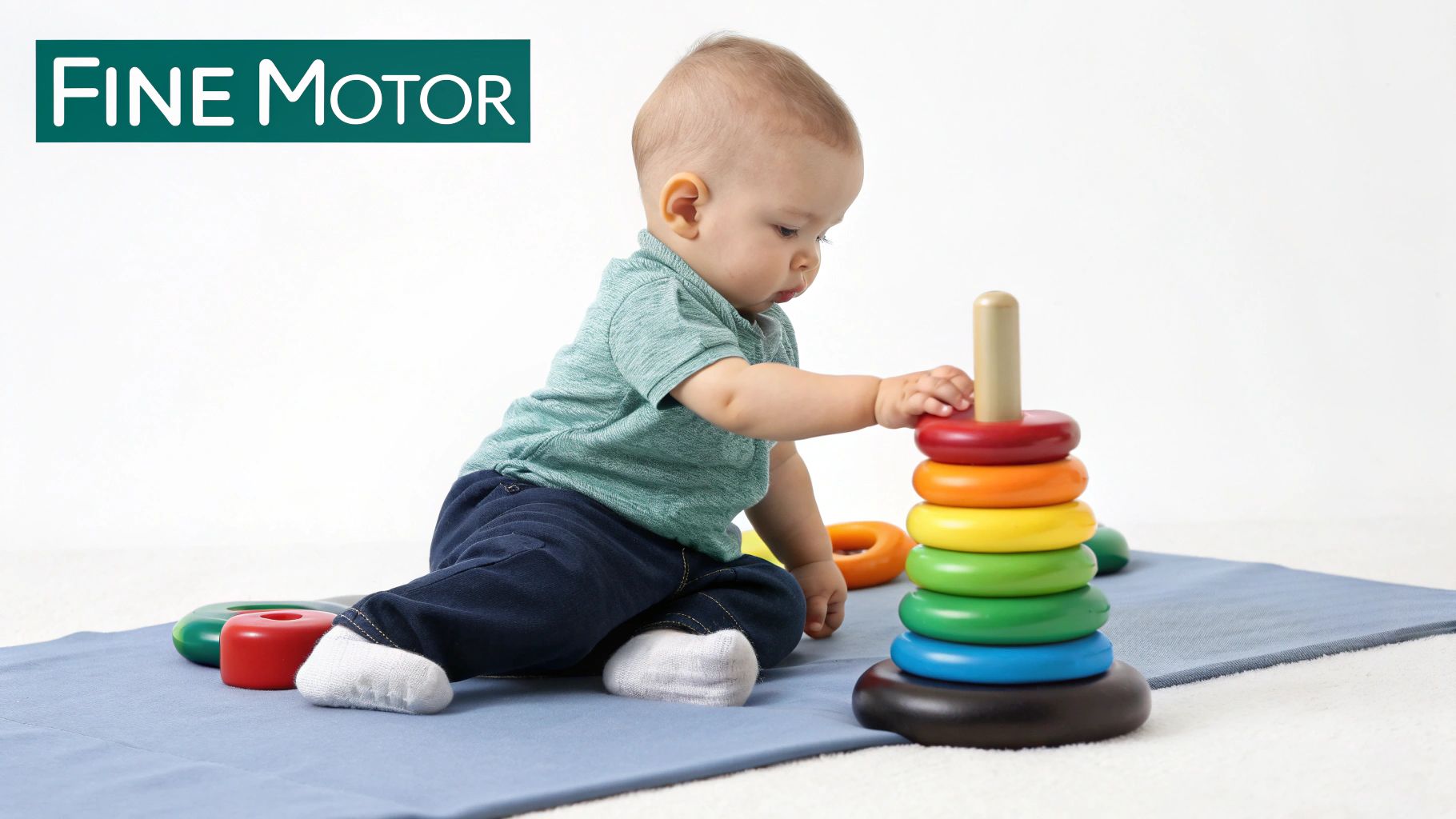
It’s easy to feel the pressure to buy the "best" educational toys. We're constantly hearing about the importance of early years learning, and that instinct to fill a shopping basket with stimulating items can be pretty powerful.
This isn't just a feeling; it's a nationwide trend. In fact, consumer spending on games and toys in the UK has nearly doubled over the past two decades. This boom shows just how much parents now prioritise items designed to support their baby’s growth. You can see more details on this in the UK toy industry spending data on statista.com.
But here’s a secret: the most powerful learning tools for your newborn might not come from a box at all. Your home is already a developmental wonderland, packed with sensory treasures just waiting to be discovered.
Everyday Objects as Sensory Toys
Before you click ‘buy now’ on another toy, just take a look around your house. You’ll be amazed at how many ordinary, baby-safe items can offer incredible sensory experiences perfect for a newborn. The goal isn’t to ditch purpose-built toys entirely, but to realise that you already have a wealth of resources right at your fingertips.
Here are a few simple ideas to get you started:
- Tactile Exploration: During tummy time, let your baby feel a soft, silky scarf. That smooth texture is fantastic sensory input.
- Auditory Discovery: Gently and safely crinkle a piece of parchment paper near your baby’s ear. It makes a unique sound that is completely captivating and helps them start to figure out where sounds are coming from.
- Visual Tracking: Slowly move a shiny (and unbreakable!) measuring spoon back and forth in front of their face. The way it catches the light is fascinating for their developing eyesight.
Your interaction and creativity are what truly bring the magic. The most 'educational' toy is often just one that helps you connect with your baby—and that can be as simple as your own singing voice during a nappy change.
Turning Routines into Play
There’s no need to carve out a special time for “educational play.” The real trick is to weave these little sensory moments into the routines you're already doing every single day.
Bath time, for instance, is a goldmine for sensory learning. Let them feel the gentle splash of water on their skin. Talk them through what’s happening—"Here comes the warm water!"—to start building their language skills from day one. Suddenly, a simple daily task becomes a rich, multi-sensory experience.
Even story time can be dialled up a notch. As you read, try using different voices for the characters or gently tapping the pictures on the page. This approach engages multiple senses at once, helping to build stronger neural connections. If you’re looking for some great reads, check out our guide on the best board books for babies.
By seeing the learning potential in everyday objects and moments, you can create a wonderfully stimulating environment that nurtures your baby’s growing brain—all without cluttering your home or your budget.
Your Questions About Newborn Toys, Answered
Stepping into the world of parenthood brings a tidal wave of questions, and when it comes to toys for newborn development, it can feel like there's a lot to learn. How many do we need? Which ones are actually safe? We’ve gathered the most common questions from new parents to give you clear, straightforward answers and help you feel confident.
Think of this as your friendly guide to navigating the newborn toy landscape. There are no silly questions here, just practical advice to support you and your little one on this incredible journey.
How Many Toys Does a Newborn Actually Need?
Honestly, not many at all. It’s so easy to get caught up and feel you need to buy everything, but the truth is, your newborn's world is already bursting with stimulation. Your face, your voice, and your gentle touch are the most engaging and important "toys" they could ever have.
So, focus on quality over quantity. A small, carefully chosen collection of just three to five high-quality, sensory-rich items is more than enough for the first few months. A great starting set might include:
- A high-contrast book or a set of flashcards
- A soft, lightweight rattle
- A play mat with an engaging, simple design
Simply rotating these few items will keep them feeling fresh and exciting for your baby. This approach prevents them from becoming overstimulated while still providing brilliant opportunities for learning and discovery.
Are Electronic Toys with Lights and Sounds Okay for Newborns?
It’s best to stick to simpler, more traditional toys for the first three months. A newborn’s brain is still figuring out how to process even the most basic sensory information, and the flashing lights and multiple sounds from complex electronic toys can easily become overwhelming.
Instead, look for toys that respond directly to what your baby does. A rattle that makes a noise when they shake it, for example, is a powerful early lesson in cause and effect. Simple toys that engage their budding senses—like those with bold patterns or gentle, natural sounds—are far more suited to this early stage.
The best newborn toys are the ones that invite interaction and exploration, rather than just passive entertainment. They become a bridge for connection between you and your baby, and that’s where the real developmental magic happens.
When Do I Start Tummy Time and What Toys Can Help?
You can start doing tummy time right from your first few days at home. Begin with just a minute or two at a time, a few times a day. It might not seem like much, but these short sessions are absolutely crucial for building the strength your baby needs for future skills like rolling over and crawling.
To make it more engaging, place a captivating toy in front of them. This gives them a real reason to lift their head and strengthen those important neck, back, and shoulder muscles. A couple of fantastic tummy time tools are:
- An unbreakable mirror: Babies are completely fascinated by faces, especially their own reflection.
- A high-contrast board book: You can prop it up in front of them so they can focus on the bold, simple images.
These simple props can transform what is essentially a baby workout into a fun, interactive play session.
How Can I Be Sure a Toy Is Safe for My Newborn?
Safety is, without a doubt, the top priority. When you're choosing toys, always look for the UKCA or CE mark. This is your assurance that the product meets the UK's strict safety standards.
Opt for items made from non-toxic materials like BPA-free plastic, food-grade silicone, or natural, unfinished wood. Most importantly, make sure there are no small, detachable parts that could become a choking hazard. A good rule of thumb is that any toy, or any part of it, should be too large to fit entirely inside your baby's mouth.
Feeling confident about choosing the right toys is a huge step. If you love the idea of getting expert-curated, stage-based play kits delivered right to your door, you might want to explore the Grow With Me subscription box. We take all the guesswork out of playtime so you can focus on connection. Discover our play kits at https://shop.growwithmesubscriptionbox.co.uk.
